
The commercial brewing of beer in Fiji only commenced in 1958 and the market is dominated by a single producer, Paradise Beverages (Fiji) Limited.
Contents
The Fijian word for beer is bia.

The commercial brewing of beer in Fiji only commenced in 1958 and the market is dominated by a single producer, Paradise Beverages (Fiji) Limited.
The Fijian word for beer is bia.
There was no alcohol in Fiji until the arrival of outsiders. Before this, yaqona (kava) was the traditional ceremonial drink used by men. In Fiji alcohol in various forms was introduced in the early 19th century by explorers, traders, whalers and to some extent missionaries. Missionaries of the London Missionary Society and the Methodist Church arrived in the 1830s.
During the Second World War, American soldiers introduced brewing and distillation with which the Fijian soldiers became familiarised. Fiji became a British colony in 1874 and achieved independence in 1970. As in the other Pacific Islands, a permit system was set up to control alcohol accessibility. In Fiji, the permit system did not apply to Europeans, but only to Fijians and Indians.
No permits were issued to women, either Indian or Fijian, or to young men (under the 25 years in the case of Indians, and under 30 years in the case of Fijians). In 1958 restrictions on access to beer were removed for adult males of any race and four years later, in 1962, adult males were allowed access to any alcoholic beverage. The restriction on the sale of alcohol to females was repealed in 1969.
In 2019 the average consumption of alcohol per capita (15+) was 1.59 litres (0.42 US gal), 2.6 litres (0.69 US gal) when adjusted to include tourist consumption, with beer being 70% of all alcohol consumed. Since 2014, consumption of beer per capita in Fiji has fallen by 0.9% on an annual basis. The peak consumption of 2.16 litres (0.57 US gal) occurring in 1990. In 2019, the country was number 95 amongst all other countries in beer consumption per capita. [1]
Since 2014 the amount of domestic beer produced has steadily increased 5.6% annually. In 2017 Fiji was ranked number 123 in domestic beer production in the world, producing 22,000 tonnes (22,000 long tons; 24,000 short tons). [2] Fiji exported US$$302,620 worth of beer in 2019, a decrease of 2% from year to year, having peaked in 2017 at US$485,926. It was ranked at 116 in the world. [3] The importation of foreign beer has remained stable since 2014 at 1,000 tonnes (980 long tons; 1,100 short tons), and the country sits at number 135 in the world. [4]
In Fiji homebrewing is becoming increasingly popular. The home-brews are generally stronger than the commercially produced beer, sometimes containing up to three times the alcohol content of commercially produced beer, and because they are made in secret little was known about how much home-brew is being produced in the country. In 1995 the unrecorded consumption of alcohol in Fiji was estimated to be 1.0 L (0.26 US gal) of pure alcohol per capita (15+). [5] [6]
The country's first microbrewery, Island Brewing Company, commenced operations in 2009. In March 2014 it was acquired by Paradise Beverages. Currently the country's only independent brewery is Kailoma Brewing Company, which was established in 2017. Their brewery currently produces three beers: Mokusiga Pacific Lager; Cloudies Summer Ale; and Bula Bitter Brew. The current production capacity is 1,000 litres (260 US gal) per week and their beers are sold throughout Fiji. [7] [8]
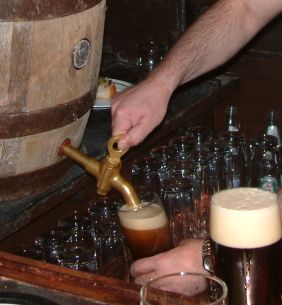
Beer is an alcoholic beverage produced by the brewing and fermentation of starches from cereal grains—most commonly malted barley, although wheat, maize (corn), rice, and oats are also used. The fermentation of the starch sugars in the wort produces ethanol and carbonation in the beer. Beer is one of the oldest alcoholic drinks in the world, the most widely consumed, and the third most popular drink after water and tea. Most modern beer is brewed with hops, which add bitterness and other flavours and act as a natural preservative and stabilising agent. Other flavouring agents, such as gruit, herbs, or fruits, may be included or used instead of hops. In commercial brewing, natural carbonation is often replaced with forced carbonation.

Low-alcohol beer is beer with little or no alcohol by volume that aims to reproduce the taste of beer while eliminating or reducing the inebriating effect, carbohydrates, and calories of regular alcoholic brews. Low-alcohol beers can come in different beer styles such as lagers, stouts, and ales. Low-alcohol beer is also known as light beer, non-alcoholic beer, small beer, small ale, or near-beer.

Beer is a major part of German culture, with only water, hops, and malt permitted as ingredients in its production, though most breweries nowadays also use yeast. Beers not exclusively using barley-malt, such as wheat beer, must be top-fermented.
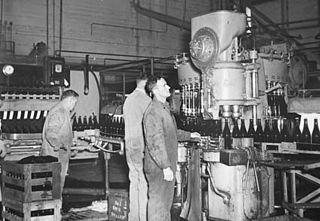
Beer arrived in Australia at the beginning of British colonisation. In 2004 Australia was ranked fourth internationally in per capita beer consumption, at around 110 litres per year; although, the nation ranked considerably lower in a World Health Organization report of alcohol consumption per capita of 12.2 litres. Lager is by far the most popular type of beer consumed in Australia.

In the United States, beer are manufactured in breweries which range in size from industry giants to brew pubs and microbreweries. The United States produced 196 million barrels (23.0 GL) of beer in 2012, and consumes roughly 28 US gallons (110 L) of beer per capita annually. In 2011, the United States was ranked fifteenth in the world in per capita consumption, while total consumption was second only to China.

Beer in South Africa has a long history, with a corporate history dating back to the early 20th century.

Beer is the most popular alcoholic drink in New Zealand, accounting for 63% of available alcohol for sale. At around 64.7 litres per person per annum, New Zealand is ranked 27th in global beer consumption per capita. The vast majority of beer produced in New Zealand is a type of lager, either pale or amber in colour, and typically 4–5% alcohol by volume.

Beer in Japan mostly comes from the country's four major breweries, Asahi, Kirin, Sapporo and Suntory, which mainly produce pale lagers around 5% ABV. Beer is immensely popular, far ahead of sake consumption.
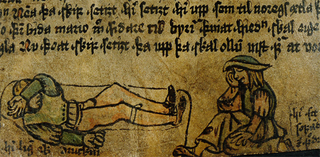
Beer in Iceland likely dates back to the island's settlement by Norsemen. In more modern history beer was effectively banned in Iceland for most of the 20th century. Since that ban was lifted in 1989, Iceland's consumption of beer has increased markedly and new breweries have begun to emerge.
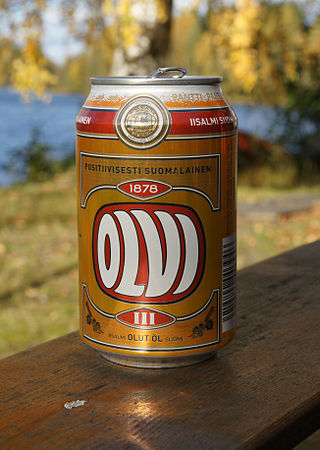
Finland has a long history of beer dating back to the Middle Ages. The oldest still-existing commercial brewery in Finland and the other Nordic countries is Sinebrychoff, founded in 1819. The Finnish Beer Day is celebrated on 13 October to commemorate the founding of the Sinebrychoff brewery and the birth of Finnish beer. The largest Finnish brewers are Hartwall, Olvi and Sinebrychoff. Most of the beers brewed in Finland are pale lagers. As of 2022, Finland's standing is 23rd in per capita consumption of beer: Finnish people consume 70.2 litres of beer annually per capita, while the total annual consumption is 393 million litres.

The primary beer brewed and consumed in Chile is pale lager, though the country also has a tradition of brewing corn beer, known as chicha. Chile's beer history has a strong German influence – some of the bigger beer producers are from the country's southern lake district, a region populated by a great number of German immigrants during the 19th century. Chile also produces English ale-style craft beers while also developing its own craft beer identity.

Alcohol has been consumed in New Zealand since the arrival of Europeans. The most popular alcoholic beverage is beer. The legal age to purchase alcohol is 18. New Zealand has an above average consumption rate of alcohol, in 2016 ranking 32nd globally in per-capita total alcohol consumption.
Alcohol consumption in Russia remains among the highest in the world. According to a 2011 report by the World Health Organization, annual per capita consumption of alcohol in Russia was about 15.76 litres of pure alcohol, the fourth-highest volume in Europe. It dropped to 11.7 litres in 2016, dropping further to about 10.5 litres in 2019. Another general trait of Russian alcohol consumption pattern was the high volume of spirits compared with other alcoholic drinks.

Most beer sold in France is pilsner lager, mass-produced by major breweries which control over 90% of the market, although there are also traditional beer styles, such as top-fermented Bière de Garde, and a number of microbreweries.

Beer has been brewed in Sri Lanka from five hundreds of years. In the 19th century, the British introduced British beer to Ceylon. The most popular beers in Sri Lanka are Lager-style beer.

Beer in Egypt has long held a significant role, and its presence in the country is thought to date back to the Predynastic period. In ancient Egypt wine was preferred by the upper class, whereas beer was a staple for working class Egyptians and a central part of their diet. Despite religious restrictions and conflicting views on alcohol after the Muslim conquest of Egypt, the consumption of beer did not cease, and it still remains the most popular alcoholic beverage in the country by far, accounting for 54 percent of all alcohol consumption.
Paradise Beverages (Fiji) Limited is a Fijian alcoholic beverage producer based in Suva. It is a publicly listed company on the South Pacific Stock Exchange.
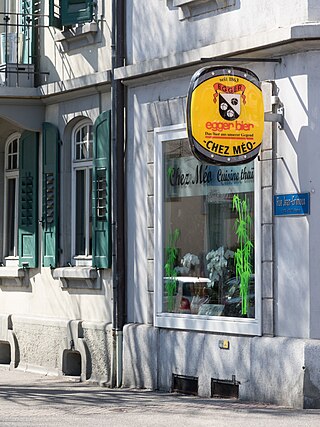
Switzerland has a long tradition of brewing, with significant domestic beer production and a growing craft brewing sector.